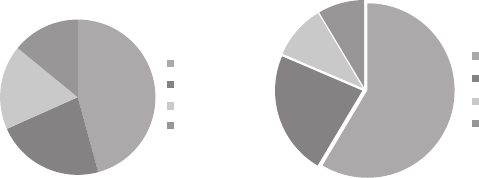Portfolio Risk Management ◾ 79
15. Assume you have worked with your cross- functional team of stakeholders to
identify the key risks affecting the asphalt company’s portfolio. There were
ve negative risks: inclement weather, health and safety concerns, lack of
resources, lack of funding, and inability to complete programs and projects
on time. A positive risk was increased demand for the product. You are
maintaining a portfolio risk register. A next step is to:
a. Assign a risk owner
b. Review the negative risks for root causes and assumptions
c. Determine potential responses for each identied risk
d. Set up triggers for the negative risks
16. Assume you have prepared your portfolio risk management plan and have
determined responses to risks to the portfolio that might occur whether they
are threats or opportunities. For those risks considered to be the most criti-
cal to the portfolio, such as a competitor releasing a similar product earlier
than planned by your company, decreasing employee morale shown by
many people leaving to take positions elsewhere resulting in lack of needed
resources, or a subcontractor defaulting that is supporting several prime con-
tractors, one way to display this information to key stakeholders is by:
a. Maintaining a complete risk register and highlighting the critical risks
b. Using a cause- and- effect diagram
c. Preparing a sensitivity analysis
d. Using Monte Carlo
17. Assume you are planning to present the results of your portfolio risk analy-
sis at the next meeting of the Portfolio Review Board. You plan to show a
comparison of the relative importance and impact of variables with a high
degree of uncertainty and to those that are more stable. A useful approach is
to prepare:
a. A probability/ impact matrix
b. An expected monetary value analysis
c. A tornado diagram
d. An assumptions analysis
18. As you work to manage portfolio risks, you decide to review the portfolio
management plan. It is helpful in identifying risks as it:
a. Provides a list of key governance decisions
b. Lists the root causes of previously identied risks
c. Lists key stakeholders that may inuence the risk posture
d. Requires an understanding of the portfolio roadmap

80 ◾ PfMP® Exam Practice Tests and Study Guide
19. Assume you are the CEO of a small, boutique portfolio, but you are risk
adverse, and your prole is dominated by one high risk component as
shown in the following graph. Your goal is to move to a target portfolio,
which can be characterized as medium risk even though its expected return
is lower. This graphic shows:
Desired Portfolio
Component 1
Component 2
Component 3
Component 4
Current Portfolio
Component 1
Component 2
Component 3
Component 4
Medium Risk
Expected
Return = 6%
High Risk
Expected
Return = 10%
a. The importance of balancing risks versus rewards
b. The problem of having only a few components in the portfolio
c. The need for greater quantitative analysis approaches to calculate overall
return
d. The need to focus on investment choices
20. Assume you are one of ve owners in a start- up company, and your plans
are to enter the low calorie food market, given the number of obese people
of all ages; provide easy- to- heat and nutritious food to military person-
nel stationed overseas; enter the ice cream market with new and delicious
avors; and also offer dark chocolate candy. You have put together your
strategic plan and have hired people to lead the new product offerings plus
people for internal operations. Each new product development head has at
least 20 components. This is a situation in which:
a. Resource allocation is critical
b. The quantity of components requires balancing
c. The quality of portfolio management may be a structural risk
d. Market leader ship is a key to portfolio success

Portfolio Risk Management ◾ 81
Answer Sheet
1. a b c d
2. a b c d
3. a b c d
4. a b c d
5. a b c d
6. a b c d
7. a b c d
8. a b c d
9. a b c d
10. a b c d
11. a b c d
12. a b c d
13. a b c d
14. a b c d
15. a b c d
16. a b c d
17. a b c d
18. a b c d
19. a b c d
20. a b c d
Portfolio Risk Management ◾ 83
Answer Key
1. d. Risk owners
Other areas around risk management that are due to planning include
portfolio risks affecting the organization, risk tolerance, and risk pro-
cesses. They are part of weighted rankings and scoring techniques, a
tool and technique in the Develop Risk Management Plan process.
Portfolio Management Standard, p. 125
Task 2 in the ECO in Risk Management
2. d. An event with an impact on the portfolio
Issues differ from risks and are different at the portfolio level than
at the program or project levels. It is an event with a current impact
on the portfolio. Negative risks if they are not identied and treated
become issues; and positive risks if not identied or treated are lost
opportunities.
Portfolio Management Standard, p. 131
Task 4 in the ECO in Risk Management
3. a. Realign the budget to better manage risks
The purpose of collecting and reviewing the portfolio risk information
is to enable the governance group to evaluate the portfolio to determine
whether rebalancing components, resources, or the budget is required
to realign portfolio risks.
Portfolio Management Standard, p. 132
Task 6 in the ECO in Risk Management
4. c. The next step is a risk assessment for the organization
This situation is a need to update organizational process assets, an out-
put to the Manage Portfolio Risks process.
Portfolio Management Standard, p. 135
Task 6 in the ECO in Risk Management
..................Content has been hidden....................
You can't read the all page of ebook, please click here login for view all page.
